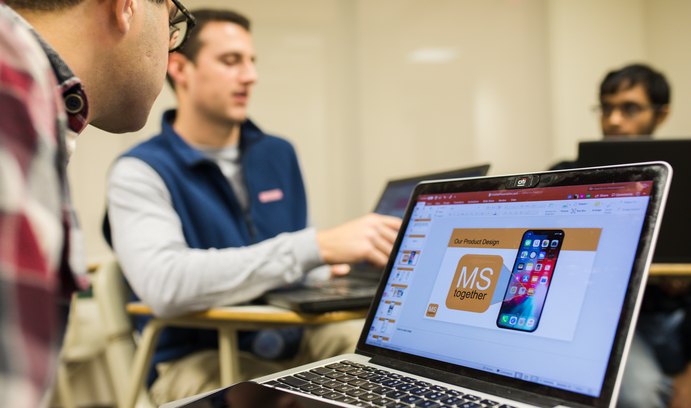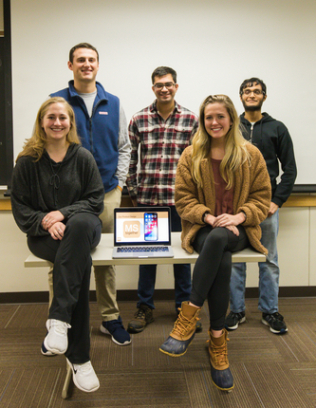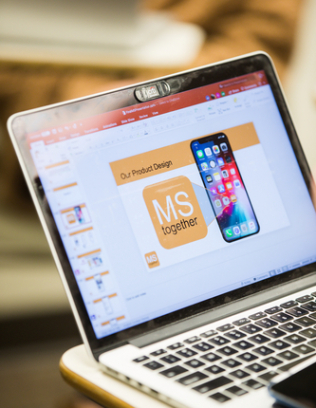IBE Project Aims to Help MS Patients Connect

From left: Roshan Giyanani '19, Jake Homan '19 and Anil Morisetti '19 plan the finishing touches of their new social media app. The app, called MS Together, helps multiple sclerosis patients connect with each other and share their stories.
In the first months of 2018, a team of Integrated Business and Engineering students were given a single task to work on for the year: Help improve the quality of life for multiple sclerosis patients.
The team, consisting of students Roshan Giyanani ’19, Jake Homan ’19, Anil Morisetti ’19, Katherine Medlock ’19 and Laura Wells ’19, worked with investor Gordon Campbell and his friends Aude and Perry Rosenrot after meeting them during an IBE project roundtable at the start of the spring 2018 semester.
Offered jointly by the P.C. Rossin College of Engineering and Applied Science and the College of Business and Economics, IBE integrates courses in business and engineering with additional requirements in mathematics, science, English, humanities and foreign language. A highlight of the program is its two-semester, six-credit capstone design course, which allows teams of students to work with faculty mentors on the marketing, financial planning and feasibility of new product concepts which, in this case, involved working directly with MS patients and their needs.
Homan said a patient who’s been living with MS since the early 2000s was having issues finding information about a type of boot they could wear to reduce numbness. When the patient couldn’t find the boot, they figured a service could be created to connect with others in similar situations.
The range of patient experiences led the team to create a social networking app that would facilitate communication between MS patients and provide easily accessible resources to form communities. Giyanani said the team’s app, called MS Together, pulls data from online sources such as Facebook or Google and information from Project Floodlight, an open-source project that builds software-defined networks that can be used to monitor and track patient symptoms.
While apps such as MSBuddy and PatientsLikeMe already exist on the market, Giyanani said they often struggle to match users who are truly similar. By combining related data sets, Giyanani said the team’s matching algorithm forms groups through common interests and hobbies and provides more accurate patient connections.
“We had to do some research figuring out what MS was and the problems that people with MS face,” Giyanani said. “One of the things we hit on was the feeling of loneliness and lack of opportunities to empathize with people going through similar experiences.”
Current research estimates that up to 1 million people in the United States are diagnosed with MS, three-quarters of them women. The disease affects the nervous system and can disrupt basic bodily functions, though symptoms differ dramatically between patients. For instance, Giyanani said some patients may be able to walk and drive while others require assistance or have larger cognitive issues.
“For instance, Laura and I signed up for PatientsLikeMe to get paired up with people,” Giyanani said. “Laura got paired up with an older man, and I got paired up with women that were 20 years older than me and had kids. It’s hard to relate with those kinds of things, particularly with MS since it can affect people of all different ages and issues.”
Homan said the team pivoted from a health-related app to a more socially oriented focus after he, Giyanani, and Medlock attended the annual Consortium for MS Centers in Nashville in May 2018. He said they had the opportunity to present their idea to patient support groups and fine-tune its social components to fit the community's needs.
“For instance, if there’s a bunch of newly diagnosed MS patients that are really into hiking and don’t know other people interested in hiking that have MS,” Homan said, “there could be a suggestion that’s like, ‘Hey, there’s other people in the Lehigh Valley that are interested in hiking. Would you like to group with them?’ Something so they can have shared experiences, maybe even outside the application.”
With the fall semester at a close, Morisetti said the team has been putting the finishing touches on the app, creating mockups and a workable user interface. The team spent their remaining weeks arranging a business plan for the app before presenting their work in front of Campbell and the Rosenrots.
“The best feeling we had was when we presented to the MS support group and the feedback we got from both the patients at Good Shepherd and the MS Society,” Homan said. “They were so happy and willing to help. That feeling was awesome, that validation, and the fact that it might be able to make a difference in the future is very heartwarming.”
MS Together does not currently have a release date. After the presentation, Campbell and the Rosenrots will oversee the product’s execution and implementation.
Story by Sam Topp
Photos by Christa Neu
Posted on:





